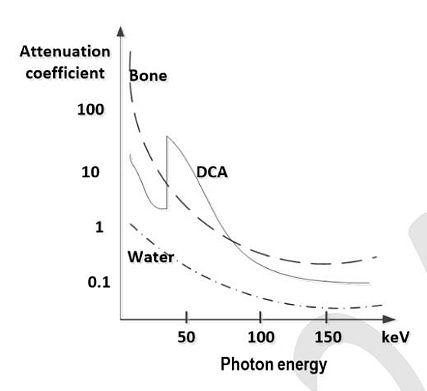Question:
When a metal target is bombarded with high-energy electrons, the electromagnetic waves generated are
When a metal target is bombarded with high-energy electrons, the electromagnetic waves generated are
Show Hint
High-energy electron collisions with a metal target produce X-rays due to the deceleration of the electrons and the release of energy.
Updated On: May 15, 2025
- infrared waves
- microwaves
- X-rays
- gamma rays
Hide Solution
Verified By Collegedunia
The Correct Option is C
Solution and Explanation
When high-energy electrons collide with a metal target, they decelerate rapidly, causing them to lose energy in the form of electromagnetic radiation. The energy lost is emitted as X-rays, a type of electromagnetic radiation with wavelengths shorter than ultraviolet radiation. This process is the principle behind the generation of X-rays in X-ray tubes.
Thus, the correct answer is \( \boxed{\text{X-rays}} \).
Was this answer helpful?
0
0
Top Questions on X Rays and the Ordering of the Elements
- The shortest wavelength, present in X-rays produced by an accelerating potential of 50kV, is:
- CUET (PG) - 2025
- Material Science and Technology
- X Rays and the Ordering of the Elements
- In Laue's technique of X-ray diffraction, a single crystal is held stationary and the beam of white radiation of wavelength \(\lambda\) is inclined at which condition with glancing angle (\(\theta\)):
- CUET (PG) - 2025
- Material Science and Technology
- X Rays and the Ordering of the Elements
- The minimum wavelength of X-rays produced by 20 keV electrons is nearly
- AP EAPCET - 2025
- Physics
- X Rays and the Ordering of the Elements
- An X-ray beam of initial intensity I0 of 70 keV imaging the chest is assumed to undergo attenuation through the muscle tissue for a thickness of 16 cm and further through the bone tissue for a thickness of 4 cm. The half value layer (HVL) thicknesses for the muscle and bone are 3.5 cm and 1.8 cm, respectively. The percentage of X-ray intensity transmitted through the body is ________.
Give your answer rounded off to 2 decimal places.- GATE BM - 2024
- Medical Imaging Systems
- X Rays and the Ordering of the Elements
- The X-ray attenuation coefficients as a function of photon energy for three materials are shown in the figure below. A tissue phantom containing these three materials is imaged at two different X-ray photon energies of 50 keV and 150 keV. When the developed X-ray film is viewed, which of the following statements is/are TRUE ?

- GATE BM - 2024
- Medical Imaging Systems
- X Rays and the Ordering of the Elements
View More Questions
Questions Asked in AP EAPCET exam
- If the de Broglie wavelength of an electron is \( 2 \, \text{nm} \), then its kinetic energy is nearly (Planck's constant \( = 6.6 \times 10^{-34} \, \text{J s} \) and mass of electron \( = 9 \times 10^{-31} \, \text{kg} \))
- AP EAPCET - 2025
- Dual nature of matter
- The domain and range of a real valued function \( f(x) = \cos (x-3) \) are respectively.
- AP EAPCET - 2025
- Functions
- If a force F = (3i - 2j) N acting on a body displaces it from point (1 m, 2 m) to point (2 m, 0 m), then work done by the force is
- AP EAPCET - 2025
- work, energy and power
- Two bodies A and B of masses 1.5 kg and 3 kg are moving with velocities 20 m/s and 15 m/s respectively. If the same retarding force is applied on the two bodies, then the ratio of the distances travelled by the bodies A and B before they come to rest is
- AP EAPCET - 2025
- work, energy and power
- If a position dependent force $(3x^2 - 2x + 7)N$ acting on a body of mass 2 kg displaces it from $x = 0\, m$ to $x = 5\, m$, then the work done by the force is
- AP EAPCET - 2025
- work, energy and power
View More Questions